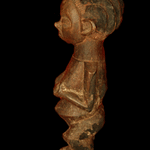Maternity Sculpture, 20th Century CE
This beautifully-finished sculpture represents a female figure (probably an ancestress), standing with slightly bent knees and supporting her breasts with her hands. Her face is small under a prominent brow;...
This beautifully-finished sculpture represents a female figure (probably an ancestress), standing with slightly bent knees and supporting her breasts with her hands. Her face is small under a prominent brow; her hair is highly ornate and arranged into a series of crests sweeping back from a forehead band.
It has the characteristics of several Gabonese, Ivorian and Zairean groups, including the Tchokwe and the Yaka/Suku people. The elegantly snubbed nose is a Yaka marker, but the form of the sculpture is otherwise atypical for this group. The multi-crested coiffure could pertain to several groups, including the Tchokwe (also the band around the forehead), the Attye/Ebrie/Anyi (Lagoons) and the Baule, while the stance of the hips and the legs is most akin to the Suku group.
While precise identity is uncertain, the theme is unmistakably that is fertility, fecundity and ancestor worship, and thus one of the pervasive subjects in all of art history. It is also a striking and attractive piece of African art.
It has the characteristics of several Gabonese, Ivorian and Zairean groups, including the Tchokwe and the Yaka/Suku people. The elegantly snubbed nose is a Yaka marker, but the form of the sculpture is otherwise atypical for this group. The multi-crested coiffure could pertain to several groups, including the Tchokwe (also the band around the forehead), the Attye/Ebrie/Anyi (Lagoons) and the Baule, while the stance of the hips and the legs is most akin to the Suku group.
While precise identity is uncertain, the theme is unmistakably that is fertility, fecundity and ancestor worship, and thus one of the pervasive subjects in all of art history. It is also a striking and attractive piece of African art.



